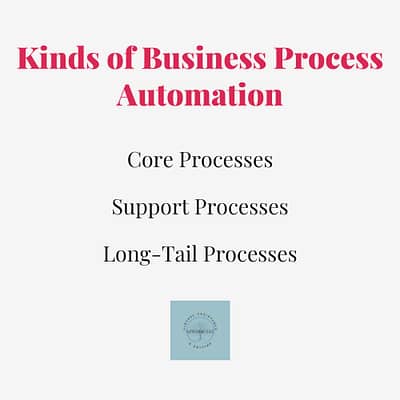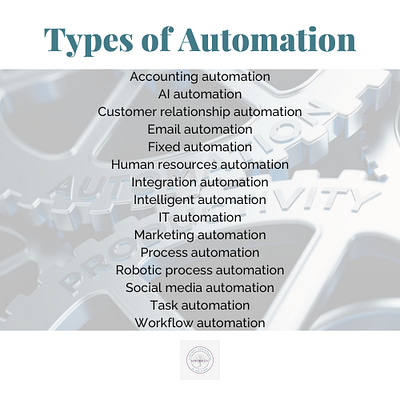
Business Process Automation
By: Colleen Atwood - Virtual Assistant & Editor
"The way you deal with automation is by upgrading people's skills so they can get the jobs of the future."
John Delaney- American Politician
Business process automation is an inevitable step for companies today. With the abundance of technology available for every aspect of our personal lives (or at least a large part of it), it makes sense that businesses are choosing to do the same for themselves. As a result, companies across each industry are experiencing increased efficiency, productivity, and profitability. So why should your company do the same thing, and what is involved?
Before an organization adds process automation technologies to its internal workflows, it must understand the individual processes. Once they gain this knowledge, the company can create cross-functional teams to ideate solutions that directly align with strategic goals and help improve customer satisfaction.
The company has various steps to work through before adding business process automation to their workflows. Our goal today is threefold:
- Learn what business process automation (BPA) is, the kind of business processes a company can automate, and the types of available automation.
- Define business process management (BPM), the types of BPM a company should know, and why the business process management lifecycle is essential.
- Understand how companies use business process analysis (BPA) to improve and streamline internal processes.
So now, without further ado, let us begin!
What is Business Process Automation?
When discussing digital transformation last month, we offered a four-part definition due to the complexity of the topic. Today, we focus on two aspects of the definition. Specifically, “business process analyses and enhancement to increase employee productivity and agility; and a customer-driven approach using technology to increase competitiveness within a shifting marketplace.” But what is a business process?
Companies use business processes (or fixed activities employees perform to achieve a specific goal). There are five primary categories (core, supporting, long-tail, strategic, and management), and each uses a distinct set of processes (or workflows) to achieve its goals. However, due to the interconnected nature of business, activities performed in one part of the company typically affect another activity elsewhere (even if the connection is not clear at first).
Because efficient execution of business processes directly contributes to the organization’s success and growth, the goals of each business process should be specific and designed to produce a predictable result. When inconsistency becomes an issue, then it is up to the company to implement business process management (BPM) to improve those processes. Therefore, it is in each organization’s best interest to work toward understanding each process as thoroughly as possible and find innovative ways to enhance efficiency and productivity.
Companies adopt business process automation (BPA) (or advanced technology to replace—or minimize—repeatable activities within a process) to help create a more cost-efficient and streamlined system. Further, automating specific parts or portions of a workflow helps improve efficiency, reduces error rates due to human intervention, and increases the possibility of introducing new business models to the firm with less employee resistance.
Reasons to Automate Business Processes
Companies have multiple reasons to automate their business processes, including:
- Automation helps companies meet and exceed changing customer expectations, which allows companies to increase customer satisfaction.
- Automation is among the first steps to digital transformation.
- Businesses create standard operating procedures (SOPs), which clearly outline each step in a process and how to use all automated technologies to complete a goal.
- Organizations take the time to discover and eliminate (or improve) redundant steps in a process, which helps improve its effectiveness.
Kinds of Business Processes
The primary kinds of business processes companies use include (1) core, (2) support, (3) long-tail, (4) strategic, and (5) management. We are focusing on the first three today.

Core Processes. The organization’s core (or primary) processes are crucial for business operations and actively create value for customers (who are willing to pay for the products or services). Standard core processes for companies include sales, marketing, operational, service development, and customer support.
Support Processes. The support processes are the internal workflows that happen in the background for the core processes. Such workflows align with specific departments and have no direct effect on generating revenue for the firm. Standard support processes include human resources, IT, finance, logistics, and procurement.
Long-Tail Processes. A firm’s long-tail processes fill in the gaps between existing core and supporting processes but remain unique enough to respond to evolving business needs quickly. Often, these processes combine human activity with task automation and use multiple systems to achieve a goal. A company’s long-tail processes may include fleet management, contract review, vendor approvals, and even creating customer case studies.
Types of Automation
The company’s business processes will vary depending on its industry, specific internal requirements, customer feedback, and competitor activity. Here is a list of common automation types found in businesses:

Now, we focus on two critical concepts when considering business automation: business process management and business process analysis.
Business Process Management
As a small business, finding the time to make significant changes to the company to remain competitive (especially when there are fewer than three people or a single individual) can take time and effort. However, there are ways to start minor changes that will one day create a stream of improvements across the firm.
Implementing business process management (BPM) forces the company to analyze each business process, learn how to support it, and seek new ways of improving existing processes to remove inefficiencies and redundancies. Further, BPM helps to foster an innovative culture of continuous improvement for all stakeholders.
Types of BPM
When we talk about business process management, we mean that there are three primary types of BPM: (1) human-centric, (2) document-centric, and (3) integration-centric BPM.

Human-centric BPM is a process that requires substantial human involvement—such as creative work like drafting blogs or social media posts—and uses different automation to complete tasks. Human-centric BPM also typically includes qualitative decision-making, approving or authorizing something, generating business reports, and other direct human interventions that automation cannot replicate.
Document-centric BPM is a process that creates paper- and electronic-based documents that must follow company policies, industry standards, and regulatory requirements. Such activities include drawing up a partnership between competitors after negotiations and developing legal documents for the court system.
Integration-centric BPM uses digital transformation to prioritize automation tools across the organization. IT departments in larger organizations typically connect diverse forms of technology, but even small businesses can learn how to interlink distinct tools using APIs and connectors.
The biggest hurdle for companies is deciding which BPM is most important to their goals. As the company grows and expands, it will eventually add both other types later. First, however, the company must figure out which BPM will help the most.
For example, Atwood LLC is a small business that produces creative work using multiple technologies. The documents produced include paper and electronic forms and need careful safeguarding using various locking filing cabinets and password-protected measures on the cloud. As a result, Atwood LLC must decide which approach we prefer to implement first. To do that, we need to understand the BPM lifecycle.
The BPM Lifecycle

Analyze. The first step (or phase) in the BPM lifecycle is for companies to map out their current processes to understand where the company is starting from and to develop an improvement plan. To do so, companies must decide their goals, name the systems that need redesigning to meet those goals, and the creation of a cross-functional team of stakeholders to work with throughout the entire process. Companies use business process analysis techniques to help.
Model. The second step is for the company to create a blueprint of what the workflow should look like. During this phase, companies need to know the inputs and outputs and create flowcharts that map out different scenarios for the process. Once the model is complete, firms evaluate how they might implement automation at specific points and even decide if a particular process is necessary. Then, the company works closely with the cross-functional team to find potential solutions to improve the process and designs a new flowchart showing the ideal model and improvements.
Implement. Companies should create a test during the implementation phase to see how the new process workflow works. Companies can make the necessary adjustments if problems arise or something does not work as expected. Further, organizations must ensure the new workflow is clear to employees and provide training as needed.
Monitor. After rolling out the new workflow organization-wide, businesses should check the process using KPIs and metrics. Over time, companies will learn where new (or unexpected) bottlenecks or areas of improvement lie.
Optimize. Companies can continuously improve each process by using feedback from stakeholders and data from the monitoring process. Typically, companies add new or adjust existing automation technologies during this phase to help streamline the process even more.
We must briefly delve into business process analysis to help explain how companies pinpoint, map, improve, monitor, and perfect their processes.
Business Process Analysis
Larger organizations have more people to ensure business process documentation happens across the firm, so employees have a reference point if needed. Small businesses, focusing on helping their customers and working toward business goals, typically need more time to create these documents.
Organizations use business process analysis (BPA) to map out and evaluate internal workflows to help see where inefficiencies, bottlenecks, redundancies, and other potential areas for improvement lie.
At the most basic level, business process analysis works through six phases to gain insight into each workflow. Here, we briefly discuss each stage for clarification.
Name the Process to Investigate

Suppose the company has multiple workflows that could use a business process analysis. To figure out where to begin, companies should:
Decide the scope (or extent) of the analysis. Ask yourself a series of questions about your processes; the answers help narrow down which are most critical and those you can put aside for the moment.
- What do you know about the process and why it might have gone wrong or is creating inefficiencies now?
- What is the company hoping to achieve by doing the analysis?
- Where does each process begin and end?
- Which processes create more problems than solutions?
- Who takes part in each, and what are their needs and expectations?
Create a cross-functional team directly affected by the process (or processes). By doing so, people from across the organization can give input on how each workflow runs and offer their ideas for improving it.
Clarify the goals the firm wants to achieve with the analysis. Expand on the company’s hopes and be as specific as possible. The goal is to align the firm’s business process analysis goals with the organization’s strategic goals.
Select the methods and tools the company will use during the analysis. Companies typically use a combination of different methodologies to help them decide which workflows to address. Such methods include critical path analysis, flowcharts, root cause analysis, and value stream mapping. Another crucial tool to help keep your BPA organized is to use a project management tool. That way, everything is in one place and easily accessible.
Map Out Workflows and Collecting Relevant Data
Companies should create a visual model of the process (or processes) the company wants to analyze. To map the workflow out, companies should:
Write out the steps (or activities) you are analyzing in detail. Working closely with the cross-functional team, list each step of the process in as much detail as possible. You will use this information when you begin creating your flowchart.
Create flowcharts, diagrams, and process maps. Using the Unified Modeling Language (UML), create a visual flowchart of your process in sequential order. Make sure to include decision points, inputs, outputs, documentation, and sub-processes (depending on the type of flowchart you decide to use).
Gather relevant data for each process step, including details from those involved. The data you need to collect must be related to the specific process, including the time it takes to complete each step, resource use, error rates, and other relevant metrics.
Scrutinize the Process for Issues
Firms then take time to evaluate the process closely to find inefficiencies. Throughout this evaluation, the company should:
Refer to the cross-functional team for answers about the process. Specifically, companies should learn as much as possible about why a step takes longer than necessary and how it contributes to errors within the process. The individuals directly involved in the process are the best source for learning these answers.
Research industry benchmarks and best practices. Find as much information online as possible about the specific process the company is analyzing and if benchmarks are available. If none are, use the internal data collected as your benchmark for improvement. Find out what the best practices are for the industry and include them as much as possible in your redesigned workflow.
Brainstorm potential solutions. Have a brainstorming session with your cross-functional team to find short- and long-term solutions for the areas of interest. A company can find unique solutions using employees who view the process from various perspectives.
Prioritize the solutions and create KPIs and metrics. Decide which solutions are a better fit based on the criteria of your goals, resources, and level of importance. Keep a list of the remaining solutions for future reference. The company may be able to include those solutions sooner than they expect. Finally, decide the KPIs and metrics the organization will use to monitor the new process.
Redesign the Workflow
The next step is to redesign the workflow with the agreed-upon solutions. To do this, companies should:
Create a new flowchart showing the updated process. Design an improved flowchart for the process using prioritized solutions and best practices. Make sure to note the specific issues the solutions address.
Create an implementation plan. To ensure a smooth roll-out, create an implementation plan outlining the resources needed, the expected timeline introduction and full implementation should take, who manages which portions of the new process, and the possible challenges the firm may face in the new process.
Evaluate the solution with a smaller group. Find a group of volunteers within the cross-functional team familiar with the original process and have them use the new process for a specific time. Their feedback can help resolve unforeseen issues and refine the process further.
Communicate and prepare training materials for the new process. Communication from upper management is critical to ensuring all stakeholders understand the new process. Management should prepare training materials for the new process to lessen employees’ resistance.
Implement the New Process
Next, the company can:
Roll out the new process. Make the new process available across the organization and collect regular feedback from stakeholders on how the process is working.
Monitor the new process’s progress. Watch the problem areas closely. Use the established KPIs and metrics to learn how the improved process works.
Continual Monitoring & Improvement
Finally, the company should:
Continually collect feedback from stakeholders. Implementing a new process does not mean it is complete. As time passes, unexpected problems may arise, and the company should have a plan for tweaking the process as necessary.
Document the changes. Create a comprehensive file that includes everything about the process, including the original state, the changes made, how the improvement affects performance, and standard operating procedures for the process from beginning to end.
Measure and optimize the process as necessary. As you gain insight from the KPIs and metrics applied to the new process, use the information to make new decisions about potential improvements.
Wrap Up
Companies that streamline their business processes by adding automation can stay competitive, efficient, and productive. By methodically working through the business process management system and applying business process analysis to each workflow (regardless of where in the organization), small businesses and larger organizations can ensure their customers receive the best they can offer when they need it.
For more details on digital transformation, see the blog post and check back often on the Business Consultant Resource page for downloadable materials. Until next time.

